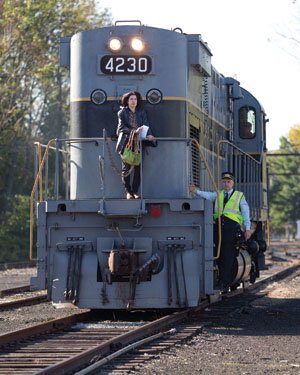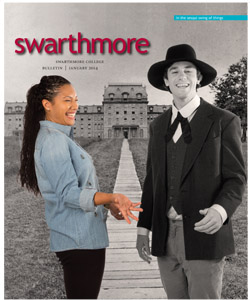Tracking on 150 Years
I’m no George Plimpton, but I do enjoy participatory journalism, especially when it involves climbing around on a train. Well, participatory may be stretching it. I wasn’t pulling the throttle on the train engine. I was just along for the ride with Conductor Frank Moscatelli, whose day job is teaching physics at Swarthmore.
on a train. Well, participatory may be stretching it. I wasn’t pulling the throttle on the train engine. I was just along for the ride with Conductor Frank Moscatelli, whose day job is teaching physics at Swarthmore.
Sitting in a primo spot beside the engineer, I looked out beyond the wooden ties and steel rails to see the fall colors unfold before me. It’s a view that American travelers have widely enjoyed since trains began traversing the country coast to coast in the 1860s. That same decade Swarthmore College was founded, and the site for the new college was picked for its proximity to a depot. The importance of rail lines to the College—then and now—is the subject of one of our history-related features for this issue, which commemorates the kickoff of Swarthmore’s sesquicentennial.
Here at the Bulletin, we revere the College’s distinguished history, but we don’t think you have to be stuffy about it. History can be fun, as you can see from our cover design. Against a white backdrop, staff photographer Laurence Kesterson photographed Wynter Lastarria ’15, who was interviewed for our story on the importance of train access to the College today, and Sam Cleaves ’14, an intern for the communications department. Sam’s 1860s-era look was assembled and styled by Laila Swanson, assistant professor of design and resident costume designer. Bulletin designer Phil Stern ’84 cleverly placed the students in an 1869 scene and changed Sam from living color to black and white, as he would have appeared in photos way back when.
The fun continues with our crowd-sourced feature on campus traditions. See what your classmates have to say about curfews, the Pterodactyl Hunt, and more. And send us your own memories for inclusion in a future print or online follow-up.
I hope to see you soon here on campus at one of many extraordinary sesquicentennial-related events. See the back cover for details.
 Email This Page
Email This Page